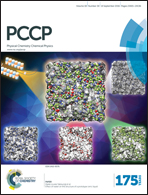A new understanding towards the reactivity of DNA peroxy radicals†
Abstract
The reactivity of thymine peroxy radicals in DNA and their fate are studied using the reliable DFT methods. The most accessible H1′ abstraction by the C6-peroxyl once reported experimentally is effectively competitive to the crosslinking reaction between the C6-peroxyl and the C5 or C6 on the 5′-adjacent thymine base. The rare transfer of the ObH1′ group to the C1′ radical from the formed hydroperoxide happens with a very strong heat release. Afterwards, the parallel reactions including the H1′ and H2′ abstractions by the C6-alkoxyl in an inter-nucleotidyl manner lead to direct formation of thymine glycol. After the H1′ abstraction by the C6-alkoxyl, the apyrimidinic site can be formed on C1′ through effective N1–glycosidic bond rupture. The geometric rearrangements and the orbital interaction between the H donor and the σ-type H acceptor are used to explain the difference of the H2′ abstraction barriers by C6-alkoxyl. Hence, new radical reaction paths for the formation of DNA oxidation products are suggested, which are strongly different from the previously suggested paths with the tetraoxide intermediate.


 Please wait while we load your content...
Please wait while we load your content...